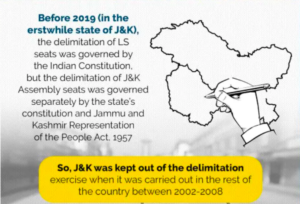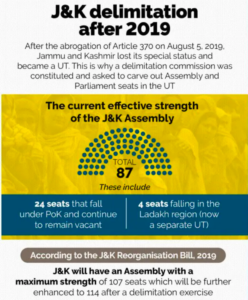ForumIAS announcing GS Foundation Program for UPSC CSE 2025-26 from 19 April. Click Here for more information.
Contents
- 1 Introduction
- 2 What is a Delimitation Commission?
- 3 What is the process of Delimitation under the Constitution?
- 4 What was the need for delimitation in J&K?
- 5 What recommendations have been made by the Delimitation Commission?
- 6 What are the concerns associated with the recommendations of the Commission?
- 7 What lies ahead?
| For 7PM Editorial Archives click HERE → |
Introduction
Delimitation is the exercise of redrawing boundaries of Lok Sabha or State Assembly Constituencies to represent changes in population over time. The exercise is undertaken by a Delimitation Commission appointed for this purpose. In this context, a Delimitation Commission set up for the delimitation of Assembly and Parliamentary Constituencies in Jammu and Kashmir has submitted its final report . It was set up on March 6, 2020. The Commission was headed by retired Supreme Court Justice Ranjana Prakash Desai and had the Chief Election Commissioner of India and J&K’s Chief Electoral Officer as ex-officio members. 5 MPs from J&K were associate members.
What is a Delimitation Commission?
The Delimitation Commission is appointed by the President of India and works in collaboration with the Election Commission of India. The Commission is made up of a retired Supreme Court judge, the Chief Election Commissioner and the respective State Election Commissioners.
The commission is mandated to: (a) Determine the number and boundaries of constituencies to make the population of all seats, as far as practicable, be the same throughout the State; (b) Identify seats reserved for Scheduled Castes and Scheduled Tribes, wherever their population is relatively large.
The Constitution mandates that the orders of commission are final and cannot be questioned before any court.
What is the process of Delimitation under the Constitution?
Under Article 82, the Parliament enacts a Delimitation Act after every Census. The Union government sets up a Delimitation Commission. Delimitation commissions have been set up four times in the past — 1952, 1962, 1972 and 2002 — under Delimitation Commission Acts of 1952, 1962, 1972 and 2002.
In 1976, the 42nd Constitutional Amendment had frozen the delimitation process until 2001. This freeze was extended till the first census after 2026 (i.e., Census 2031) by the 84th Amendment Act in 2002). In 2002, based on the 2001 Census Delimitation Commission was set up to readjust the boundaries of existing Lok Sabha and Assembly seats and rework the number of reserved seats. There was no change in the number of seats. The number of seats were frozen as a measure to boost family planning norms and to enable the State Governments to pursue the agenda for population stabilisation.
What was the need for delimitation in J&K?
In the erstwhile State, delimitation of Parliamentary Constituencies was governed by the Constitution of India and that of Assembly seats was carried out by the State government under the Jammu and Kashmir Representation of the People Act, 1957. The last delimitation exercise in J&K was carried out in 1995. After abrogation of J&K’s special status in 2019, the delimitation of both Assembly and parliamentary seats is governed by the Constitution of India.
Source: News18
The need for delimitation was felt because of:
First, Delimitation became necessary when the Jammu and Kashmir Reorganization Act, 2019 increased the number of seats in the Assembly. The erstwhile J&K state had 111 seats — 46 in Kashmir, 37 in Jammu, and 4 in Ladakh — plus 24 seats reserved for Pakistan-occupied Kashmir (PoK). When Ladakh was carved out as a Union Territory, J&K was left with 107 seats, including the 24 for PoK. The Reorganization Act increased the seats to 114 — 90 for Jammu & Kashmir, besides the 24 reserved for PoK.
Source: News18
Second, the delimitation process would ensure that constituencies become coterminous with the district boundaries. This would eventually enhance parity in the region.
Third, Delimitation is crucial for kick-starting the political process in J&K. Despite having a provision of an elected legislative assembly, the Union Territory has been devoid of the same since 2019.
What recommendations have been made by the Delimitation Commission?
ASSEMBLY: The Commission has increased 7 Assembly seats — 6 in Jammu (now 43 seats) and 1 in Kashmir (now 47). It has also made changes in the structure of the existing Assembly seats.
LOK SABHA: The Commission has redrawn the boundaries of Anantnag and Jammu seats.
RESERVATIONS: The Commission has recommended ‘provision of at least two members from the community of Kashmiri Migrants (Kashmiri Hindus) in the Legislative Assembly’. It has also recommended that Centre should consider giving representation in the J&K Legislative Assembly to the ‘displaced persons from Pakistan-occupied Kashmir, who migrated to Jammu after Partition’. The Commission has reserved nine Assembly seats for Scheduled Tribes.
What are the concerns associated with the recommendations of the Commission?
First, Constituency boundaries are being redrawn only in J&K when delimitation for the rest of the country has been frozen until 2026. In 2002, the then J&K government amended the J&K Representation of the People Act to freeze the delimitation exercise until 2026, as in the rest of the country.
Second, political parties in Jammu and Kashmir have been pointing out that the Delimitation Commission is mandated by the Reorganization Act, which is sub judice in the Supreme Court.
Third, there are concerns that recommendations violate the uniformity and equal importance of every vote in the region. Under the new arrangement, Jammu with a population of 53 lakh (43% of the total population of 1.22 crore) will have 47.8% seats, while Kashmir which has a population of 68 lakh (56%) will have 52.2% of the seats. In the earlier set-up, Kashmir’s 56% had 55.4% of the seats and Jammu’s 43.8% had 44.5% of the seats.
Fourth, the Commission did not specify whether the seats for Kashmiri Pandits should be reserved from among the existing seats, or whether they should be given additional seats.
Fifth, opposition parties have criticized that the new delimitation will skew the balance of representation against Central Kashmir and in favor of Jammu.
Sixth, while delimitation as a rule is carried out on the basis of Census population, the Commission has taken certain other factors into consideration for J&K, including size, remoteness and closeness to the border e.g., the Commission has merged Rajouri and Poonch (from Jammu division) with the Anantnag constituency in the Kashmir region. The new constituency has been renamed as Kishtwar-Rajouri. There are concerns that it might act as a barrier to the constitutional and legislative homogenisation of J&K.
Seventh, it will be the first delimitation award in the country’s legislative history that will not be placed before the legislative assembly of the UT that has been delimited. Tabling the award would have given it a democratic sanction.
What lies ahead?
The completion of the delimitation exercise is the first step towards conduct of elections in the region. Thus, it is a crucial step in the possible restoration of statehood for Jammu and Kashmir. The Union Home Minister had stated earlier this year that the statehood of Jammu and Kashmir will be restored ‘once the situation becomes normal’.
The Union Government will now fix a date from which the delimitation order will come into effect. The ECI will then rationalise the polling stations and revise the electoral rolls. Though mainstream parties in the Valley have criticized the report, it is likely that this will make space for political engagement in the region.
Source: Indian Express, Indian Express, Indian Express, The Hindu






